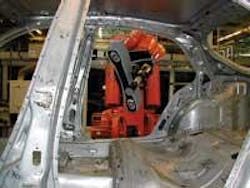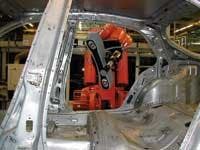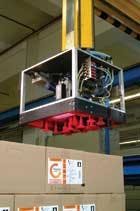Snapshots...Short takes on the leading edge
3-D system sizes car
Seeking a means for precision, off-line inspection of car bodies, Renault (Paris, France; www.renault.com) turned to ActimCM (Moirans, France; www.acticm.com) and its AdventCR 3-D measuring system, which can measure details as small as 50 to 300 μm, depending on the material and the measurement volume. The system can include up to eight intelligent vision devices (IVDs), which each contain two CCD cameras, an LED light source, and a white light projector. Each IVD can be mounted on a robot arm.
“Today, measuring the complete car body takes eight to ten hours, against two hours with the AdventCR prototype,” says Baptiste Faivre d’Arcier, the leader of the Photogrammetry Applied to Car Bodies project at Renault who validated an AdventCR prototype with a single IVD. “This time can be reduced to 30 minutes if four IVDs are used, and the cost of this system would still be equivalent to that of a coordinate-measuring machine.
ActiCM is developing other versions of the inspection system: AdventSU for automotive subcontractors, AdventSPfor aerospace contractors, and AdventME for mechanical machining.
Sensor to separate shadows and light
Despite attention to digital-camera shutter speeds and other settings, brightly illuminated parts of an image are often washed out while shadow regions are completely black. These deficiencies are being addressed by Vladimir Brajovic and his colleagues at Carnegie Mellon University (Pittsburg, PA, USA; www.cmu.edu) and Intrigue Technologies (Pittsburgh, PA, USA; www.intriguetek.com). Working in the field of neuromorphic engineering, which tries to recreate the workings of the eye, Brajovic is developing a sensor in which each pixel adjusts its sensitivity relative to the intensity of light on surrounding pixels via an algorithm that provides feedback to neighboring pixels.
Today, the sensor exists only in the form of the Shadow Illuminator-software that is available on the Intrigue Web site and as an Adobe Photoshop plug-in. Photos can be uploaded to the site for enhancement. The software takes an image, applies the algorithm to each pixel in the image, and improves the output.
High-speed imaging snaps Venus flytrap
The leaves of a Venus flytrap close on its prey in about 100 ms when its trigger hairs are mechanically stimulated. Lakshminarayanan Mahadevan and colleagues at Harvard University (Cambridge, MA, USA; www.harvard.edu) have investigated how it snaps so fast by combining a simple, theoretical model with high-speed video imaging using a Phantom V 1024 × 1024-pixel CMOS camera from Vision Research (Wayne, NJ, USA; www.visiblesolutions.com).
The flytraps were positioned in front of a pair of mirrors from the camera. The resulting stereo videos were postprocessed using ImageJ software, a public-domain image-analysis program developed at the US National Institutes of Health (rsb.info.nih.gov/ij). The plant actively controls the closure mechanism, which functions like a plastic lid that is bowed in one direction and then snaps the other way when the curvature is changed.
Vision positions robotic palletizer
From its distribution center in Friedberg, Germany, Fresenius Kabi Deutschland (Bad Homburg, Germany; www.fresenius-kabi.com) delivers dietetic and infusion-therapy products on a 24-hour basis to customers throughout the country. The products, packaged in cartons, are automatically collected and packed onto pallets by a vision-guided robotic palletizer. Precise positioning of the cartons by the robot before collection is a critical step. Although the carton position is known, cartons stacked on the pallet may shift by a few centimeters. If not correct, the vacuum gripers on the robot do not make proper contact and cartons can fall off the pallet when moved about the facility.
To guide the palletizer, Fresenius Kabi uses a Pictor smart camera and Vicolux red LED incident light source from Vision & Control (Thurinlia, Germany; www.vision-control.com). The 640 × 480-pixel progressive-scan camera is based on smart-camera technology from Vision Components (Ettlingen, Germany; www.vision-components.de) and measurement software developed using that company’s software-development kit. The lighting is integrated within the head of the robotic palletizer, and the camera is fitted with an entocentric lens that makes close objects appear larger than distant objects.
After the palletizer is positioned over a carton, the Pictor smart camera identifies the corner of the carton and compensates for varying shapes of edges and the strongly reflective adhesive tape. The palletizer has been operating successfully for more than two years, with breakdowns and losses from cartons falling off pallets significantly curtailed.
PAC automates beverage packaging
Innoventor Solutions (St. Louis, MO, USA; www.innoventor.net) has used the PXI platform from National Instruments (Austin, TX, USA; www.ni.com) as a programmable automation controller (PAC) to create a packaging system based around a six-position rotary indexing table. The PAC integrates three cameras, three stepper motors, 50 industrial digital I/O sensors and actuators, and NI’s LabVIEW software.
The system can install labels at a per-piece average cycle time of 1.4 s and can find and read the barcode on the cans with more than 150 possible color schemes and background patterns. It is also 30%-50% faster than hand labeling.


